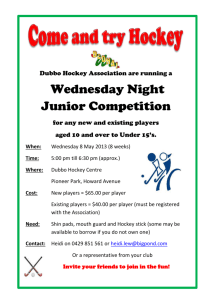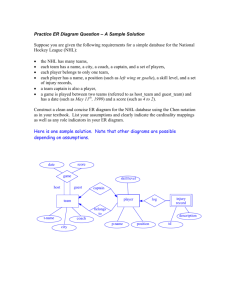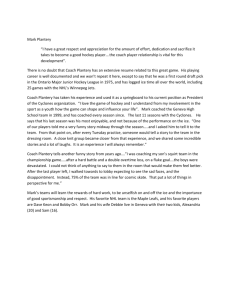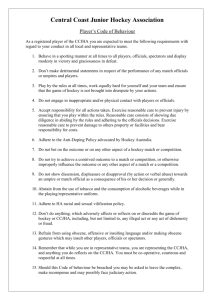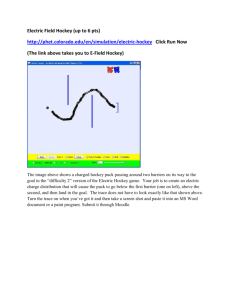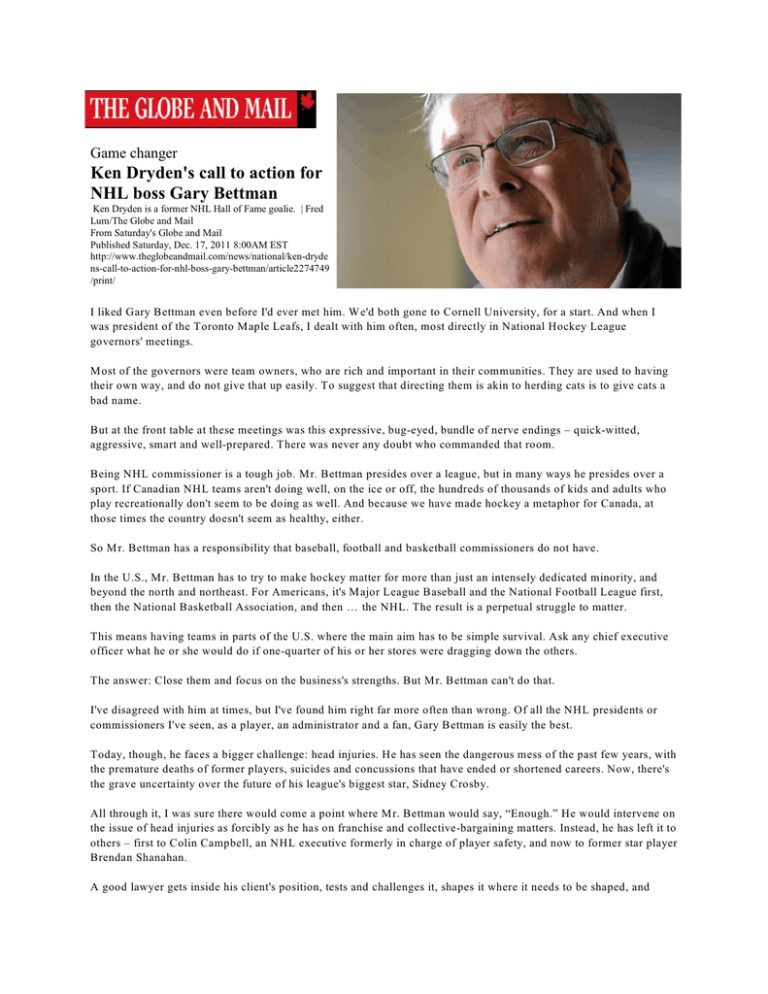
Game changer
Ken Dryden's call to action for
NHL boss Gary Bettman
Ken Dryden is a former NHL Hall of Fame goalie. | Fred
Lum/The Globe and Mail
From Saturday's Globe and Mail
Published Saturday, Dec. 17, 2011 8:00AM EST
http://www.theglobeandmail.com/news/national/ken-dryde
ns-call-to-action-for-nhl-boss-gary-bettman/article2274749
/print/
I liked Gary Bettman even before I'd ever met him. W e'd both gone to Cornell University, for a start. And when I
was president of the Toronto Maple Leafs, I dealt with him often, most directly in National Hockey League
governors' meetings.
Most of the governors were team owners, who are rich and important in their communities. They are used to having
their own way, and do not give that up easily. To suggest that directing them is akin to herding cats is to give cats a
bad name.
But at the front table at these meetings was this expressive, bug-eyed, bundle of nerve endings – quick-witted,
aggressive, smart and well-prepared. There was never any doubt who commanded that room.
Being NHL commissioner is a tough job. Mr. Bettman presides over a league, but in many ways he presides over a
sport. If Canadian NHL teams aren't doing well, on the ice or off, the hundreds of thousands of kids and adults who
play recreationally don't seem to be doing as well. And because we have made hockey a metaphor for Canada, at
those times the country doesn't seem as healthy, either.
So M r. Bettman has a responsibility that baseball, football and basketball commissioners do not have.
In the U.S., Mr. Bettman has to try to make hockey matter for more than just an intensely dedicated minority, and
beyond the north and northeast. For Americans, it's Major League Baseball and the National Football League first,
then the National Basketball Association, and then … the NHL. The result is a perpetual struggle to matter.
This means having teams in parts of the U.S. where the main aim has to be simple survival. Ask any chief executive
officer what he or she would do if one-quarter of his or her stores were dragging down the others.
The answer: Close them and focus on the business's strengths. But Mr. Bettman can't do that.
I've disagreed with him at times, but I've found him right far more often than wrong. Of all the NHL presidents or
commissioners I've seen, as a player, an administrator and a fan, Gary Bettman is easily the best.
Today, though, he faces a bigger challenge: head injuries. He has seen the dangerous mess of the past few years, with
the premature deaths of former players, suicides and concussions that have ended or shortened careers. Now, there's
the grave uncertainty over the future of his league's biggest star, Sidney Crosby.
All through it, I was sure there would come a point where Mr. Bettman would say, “Enough.” He would intervene on
the issue of head injuries as forcibly as he has on franchise and collective-bargaining matters. Instead, he has left it to
others – first to Colin Campbell, an NHL executive formerly in charge of player safety, and now to former star player
Brendan Shanahan.
A good lawyer gets inside his client's position, tests and challenges it, shapes it where it needs to be shaped, and
comes to know it, and embody it, as well as the client himself. Mr. Bettman is a very good lawyer. His relentless
rigour gives him his confidence, his presence and posture. He needs to know he's the smartest guy in the room. That's
what allows him to herd his cats.
But when he can't quite get inside his client as deep as he needs to go, his manner changes. He knows how much
hockey means to Canadians, but, as an American, he can't quite know. He knows how proud, almost warrior-like,
hockey players see themselves, but as someone who has never played the game, he can't quite know.
Often criticized in Canada for being an American (and all that means to Canadians), in fact he has been a determined
advocate for things Canadian. He knows that the NHL isn't strong and healthy unless hockey in Canada is strong and
healthy. On matters Canadian, he is respectful and deferential. He listens. About on-ice matters, he is the same: He
listens to his “hockey guys.”
The problem is that his hockey guys are so immersed in the game they have loved and played all of their lives, so
respectful of its traditions, that they haven't fully seen all that has changed. Shifts in technology, strategy and training
have allowed now-bigger players to go faster, with more forceful impact. To Mr. Bettman's hockey guys, these are
the natural evolutions of the game.
To the unintended consequences – more, and more serious, injuries – they have responded with efforts toward better
protective equipment, better medical treatment and “tweaks” to the rules.
W hat they've missed is that technology, strategy and training, driven by the endless creativity of coaches, players,
scientists and entrepreneurs, always outrun such moderate adjustments.
Better helmets, more muscular necks and shoulders, MRIs and Rule 48 haven't offered the answer to 220-plus-pound
players moving 30 miles an hour. Not even close. But to intervene with anything else – with significant rule changes
that would make the game be played in a more “head-smart” way – to them is unthinkable. That's not natural
evolution; those are “unnatural intrusions.”
Mr. Bettman's hockey guys forget that at one point hockey's natural evolution was toward a jammed-up, goalless
future – until someone intruded unnaturally with player substitutions and the forward pass. Imagine what the hockey
guys of that time would have said.
A Bettmanesque approach
I decided about two months ago to get back in touch with him (“Go Big Red!”). A few days after the start of the new
season, I sent him an e-mail to congratulate him on the return of the W innipeg Jets. He e-mailed back right away, and
at the end of our back-and-forth we each promised that (when I'm in New York or he's in Toronto), we'd catch up.
Not long ago, we e-mailed again and said we'd make it happen early in the new year.
W hat I was intending to say to him in that meeting is that it's time not to be so deferential and respectful on hockey
matters – on head injuries. It's time to take them on, in his aggressive, Bettmanesque way.
I wanted to say: These head-injury stories are not just a run of bad luck that will turn. This is your future for as long
as you are commissioner. You can try to deny the problem, you can try to manage it, or you can do something. And,
as overwhelming as it seems, the changes necessary are not impossible.
Few of us are blaming you. Clearly there is so much we don't know: W e don't know the dimensions of the problem.
W e don't know the dimensions of the answer. But we do know the issue exists, and some of what must be done.
Hockey isn't the only sport affected – if anything, football's problem is far greater; soccer and other sports are also
experiencing it. Outside sports, the military is coping with the effects of new, more-concussive weapons. And for
decades, we've overlooked the consequences of head trauma in child-abuse cases.
The NHL doesn't need to lead this effort – in fact, it's better if you don't, to avoid the inherent conflicts of interest.
But you can signal your determination. You can help create some ongoing structure that would generate public
discussion, proposals and action.
For example, you could help sponsor an annual conference, hosted by a university, first in Canada, but later in the
U.S. and Europe. The best brain scientists would be there. Players who've been injured would tell their personal
stories. League officials from different sports would talk about what's worked and what hasn't. The best coaches and
players would talk about creative ways to play under new “head-smart” rules: If you can't do some things the old
way, what do you do that might be even better than what you did before?
Each year, there will be new findings, new ideas and fresh challenges to players, coaches, officials, scientists and
entrepreneurs who feed on fresh challenges. And you'd be there to show that you are in on this problem for the long
run.
There is no running away. The need is to begin.
Remembering Derek Boogaard
That's what I was going to say to Mr. Bettman in January or February. Then I saw his video interview this month on
The New York Times website. The Times had published an outstanding three-part series about Derek Boogaard, the
28-year old NHL “enforcer” who died in May, and this was a follow-up.
Mr. Bettman began his response to one question with the often-repeated story: Fighting has a long history in the
game; players move at 30 mph in an enclosed area, carrying sticks, so there's physical contact; fighting is penalized
only in a limited way (with a five-minute penalty, not expulsion) not to sell tickets but because fighting acts as a kind
of “thermostat,” so that “things don't go too far” – the threat of fighting helping to keep other matters in a game
under control. Because fighting is this organic part of hockey, it changes as the game changes – sometimes more,
sometimes less – so you can't predict its future.
As for the off-ice deaths in recent months of three former “enforcers” – Mr. Boogaard, Rick Rypien and W ade Belak
– Mr. Bettman reacted to their deaths more like a father than a commissioner, describing his “almost disbelief at the
coincidental timing” of them.
“The circumstances of all three were different,” he continued. “It was a tragic, sad, unfortunate coincidence.”
Later, the interviewer pointed to recent findings by Boston University that Mr. Boogaard's brain bore signs of
chronic traumatic encephalopathy (CTE), a close relative of Alzheimer's disease, thought to be caused by repeated
blows to the head. Mr. Boogaard is the fourth former NHL player – the others being Reggie Fleming, Bob Probert
and Rick Martin – to show these indications.
W hat about this research on CTE? “I think it's very preliminary,” Mr. Bettman said. “There isn't a lot of data and the
experts who we talk to, who consult with us, think it's way premature to be drawing any conclusions at this point
because we're not sure based on the amount of data evaluated.”
He cited the “handful of samples,” all the possible factors in these players' deaths. “There's a long way to go in
medical science before people can make definitive judgments.”
This is Stage 2 in the NHL's approach to responding to issues around fighting and violence: Stage 1, as embodied by
Colin Campbell and Don Cherry, was aggressive, belligerent and dismissive: This is how the game's played, always
has been. If you don't like it, don't play it.
Stage 2 is more modulated, more thoughtful-sounding and more reasonable-sounding. Occasionally, Mr. Bettman's
lawyerly feistiness comes out, but mostly he stays on his message: Science isn't impressed with anecdote and story.
Four brain samples are merely four anecdotes, out of the thousands of people who have played this game. Science
demands proof, and I will go where science takes me. In the meantime, even with science on my side, I will continue
co-operating with doctors and researchers and change rules where appropriate. That's how reasonable I am.
But as a society we rarely have the luxury of waiting for science's standard of proof – that's how thousands of
asbestos workers and millions of smokers died. W e need to take the best science we have, generate more, apply our
best intuition and common sense – and decide. Sometimes well-observed, truth-seeking (not axe-grinding) anecdotes
can tell a lot. It's often the best information we have.
It is only by tragic fluke – his early death – that we have the Derek Boogaard “anecdote.” Normally, we'd have to
wait many more years to know what had happened. The NHL can also learn from the NFL's experience: Many more
football players than hockey players are dying now, in their 60s and 70s, after years in the living death of dementia.
Football, in that generation, was played with primitive equipment and every play – then as now – involved many
collisions.
At that same time, hockey moved at a much slower pace, players coasting, occasionally bursting, through two-minute
shifts with few collisions, and hockey fighters – normal-sized and untrained – inflicted little damage. Today, the
game moves in full-abandon 35-second shifts; collisions are never-ending and shuddering; and fighters, far bigger
and trained in combat much of their lives, can cave in a face with one punch.
Talk, listen, learn
Mr. Bettman said in his video interview with the Times that he hasn't talked to the doctors at Boston University. I
hope he does. I also hope he has spoken with Mr. Boogaard's family and friends to hear – really hear – what his life
was like. And with Paul Kariya, Eric Lindros and Keith Primeau or any of a number of players who have had their
careers ended early, about life after their injury.
And I hope he's talking with Sidney Crosby. As hard as it was in the months of recovery after his initial injury – the
pain and discomfort, the unknowns, the hopefulness, the crashing disappointments – now must be his darkest time.
W hat's shocking was the sheer ordinariness of this latest hit, the kind of light blow that is exchanged without notice
hundreds of times in a game. After 11 months, this is all it takes.
There are debates among doctors over the correlation between blows suffered now and a player's long-term future.
These debates will continue. But there can be no debate about the impact of those blows on players now – more
players with concussions, almost every day, not playing for longer, more uncertain periods of time. The debates
about hockey and CTE, to a degree, are a distraction. This is about head injuries – things we can see and absolutely
know. This is about now.
Mr. Bettman and the NHL can't use science as their shield. They must move out of Stage 2 to Stage 3: No amount of
well-modulated, reasonable-sounding words changes the fact that a hit to the head, by elbow, shoulder or fist, is an
attempt to injure that needs to result in expulsion or suspension. No amount of hopefulness and crossed fingers will
change the fact that the NHL, like the NFL, needs to start imagining and introducing “head-smart” ways to play.
And Mr. Bettman needs to be Mr. Bettman. W e look back on those 50 years ago who defended tobacco and asbestos
and think, “How could they be so stupid?” Mr. Bettman and the NHL cannot wait for this generation of players to get
old, just so they can know for sure.
Ken Dryden is an NHL Hall of Fame goaltender and a former Liberal MP.
© 2011 The Globe and Mail Inc. All Rights Reserved.

